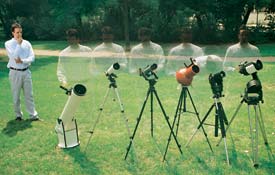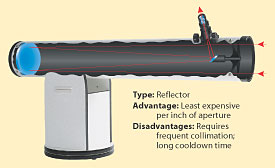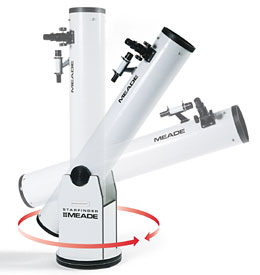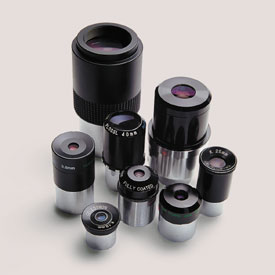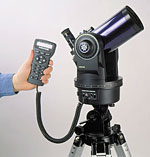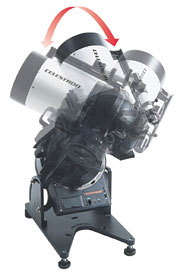 |
A Telescope's Other Half
Just as a car's engine is useless without a chassis, an optical-tube assembly is only half a telescope. Even stargazing with binoculars only really works well if you're leaning on a windowsill or reclining in a lawn chair with arm supports. And binoculars typically magnify things only 7 to 10 times. By contrast, even the smallest telescopes typically work at 30x and up. Finding objects without a mount is next to impossible at such magnifications, as are steady views.
An equatorial mount allows motion in two directions: north-south and east-west. Because one axis is aligned with the Earth's, an equatorial mount allows you to track celestial targets with a single push or knob. Furthermore, many equatorial mounts have electric motors for hands-off tracking. This is especially useful for high-magnification viewing and for showing celestial objects to groups of people. It's also a prerequisite for long-exposure photography.
An altazimuth (altitude-azimuth) mount, by contrast, permits up-down (altitude) and right-left (azimuth) motions. A video tripod is a familiar example of an altazimuth mount (and indeed, a sturdy one suffices for a lightweight, low-power scope). Another now-universal variation is the Dobsonian mount, shown below.
Altazimuth mounts are generally lighter than their equatorial counterparts, in part because they don't require counterweights to balance the telescope. |
|
(I hasten to note, however, that the equatorial "fork" mounts supplied with many compound telescopes are relatively lightweight, too; the photo above shows one example.) Dobsonian mounts, in particular, can be extremely stable and economical.
But altazimuths do not readily lend themselves to motorized operation, and you have to move the telescope in two directions simultaneously to track celestial targets. While this becomes second nature to many observers, others find it maddening. (See the section below on "smart" telescopes for a novel, high-tech way around this problem.)
Your own personality should play a part in choosing a mount. Are you comfortable with instruments that require tools and a head for numbers to set up and use? Or are you looking for the astronomical equivalent of a point-and-shoot camera? Equatorial mounts generally require several minutes of assembly, careful balancing, and polar alignment, while some Dobsonians can be set up in the time it took to read this paragraph, and some "smart scopes" on "alt-az" mounts can be deployed nearly as rapidly.
|
